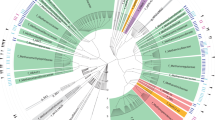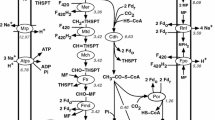Abstract
When Methanosarcina acetivorans grows on carbon monoxide (CO), it synthesizes high levels of a protein, MA4079, homologous to aldehyde dehydrogenases. To investigate the role of MA4079 in M. acetivorans, mutants lacking the encoding gene were generated and phenotypically analyzed. Loss of MA4079 had no effect on methylotrophic growth but led to complete abrogation of methylotrophic growth in the presence of even small amounts of CO, which indicated the mutant’s inability to acclimate to the presence of this toxic gas. Prolonged incubation with CO allowed the isolation of a strain in which the effect of MA4079 deletion is suppressed. The strain, designated Mu3, tolerated the presence of high CO partial pressures even better than the wild type. Immunological analysis using antisera against MA4079 suggested that it is not abundant in M. acetivorans. Comparison of proteins differentially abundant in Mu3 and the wild type revealed an elevated level of methyl-coenzyme M reductase and a decreased level of one isoform of carbon monoxide dehydrogenase/acetyl-coenzyme A synthase, which suggests that pleiotropic mutation(s) compensating for the loss of MA4079 affected catabolism. The data presented point toward a role of MA4079 to enable M. acetivorans to properly acclimate to CO.






Similar content being viewed by others
References
Ausubel FM, Brent R, Kingston RE et al (1997) Current protocols in molecular biology. Wiley, New York
Blaut M, Gottschalk G (1984) Coupling of ATP synthesis and methane formation from methanol and molecular hydrogen in Methanosarcina barkeri. Eur J Biochem 141:217–222
Boccazzi P, Zhang JK, Metcalf WW (2000) Generation of dominant selectable markers for resistance to pseudomonic acid by cloning and mutagenesis of the ileS gene from the archaeon Methanosarcina barkeri Fusaro. J Bacteriol 182:2611–2618
Boch J, Nau-Wagner G, Kneip S, Bremer E (1997) Glycine betaine aldehyde dehydrogenase from Bacillus subtilis: characterization of an enzyme required for the synthesis of the osmoprotectant glycine betaine. Arch Microbiol 168:282–289
Bouche N, Fait A, Bouchez D, Moller SG, Fromm H (2003) Mitochondrial succinic-semialdehyde dehydrogenase of the gamma-aminobutyrate shunt is required to restrict levels of reactive oxygen intermediates in plants. Proc Natl Acad Sci USA 100:6843–6848
Buschmann S, Warkentin E, Xie H, Langer JD, Ermler U, Michel H (2010) The structure of cbb 3 cytochrome oxidase provides insights into proton pumping. Science 329:327–330
Daniels L, Fuchs G, Thauer RK, Zeikus JG (1977) Carbon monoxide oxidation by methanogenic bacteria. J Bacteriol 132:118–126
Datsenko KA, Wanner BL (2000) One-step inactivation of chromosomal genes in Escherichia coli K-12 using PCR products. Proc Natl Acad Sci USA 97:6640–6645
Deppenmeier U, Müller V (2008) Life close to the thermodynamic limit: how methanogenic archaea conserve energy. In: Schäfer G, Penefsky HS (eds) Bioenergetics: energy conservation and conversion. Springer, Heidelberg, pp 123–152
Deppenmeier U, Müller V, Gottschalk G (1996) Pathways of energy conservation in methanogenic Archaea. Arch Microbiol 165:149–163
Ermler U, Grabarse W, Shima S, Goubeaud M, Thauer RK (1997) Crystal structure of methyl coenzyme M reductase—the key enzyme of biological methane formation. Science 278:1457–1462
Falkenberg P, Strom AR (1990) Purification and characterization of osmoregulatory betaine aldehyde dehydrogenase of Escherichia coli. Biochim Biophys Acta 1034:253–259
Ferry JG (1993) Fermentation of acetate. In: Ferry JG (ed) Methanogenesis. Chapman and Hall, New York, pp 304–334
Fiedler S, Wirth R (1988) Transformation of bacteria with plasmid DNA by electroporation. Anal Biochem 170:38–44
Fox JD, Kerby RL, Roberts GP, Ludden PW (1996) Characterization of the CO-induced, CO-tolerant hydrogenase from Rhodospirillum rubrum and the gene encoding the large subunit of the enzyme. J Bacteriol 178:1515–1524
Galagan JE, Nusbaum C, Roy A et al (2002) The genome of M. acetivorans reveals extensive metabolic and physiological diversity. Genome Res 12:532–542
Guss AM, Mukhopadhyay B, Zhang JK, Metcalf WW (2005) Genetic analysis of mch mutants in two Methanosarcina species demonstrates multiple roles for the methanopterin-dependent C-1 oxidation/reduction pathway and differences in H2 metabolism between closely related species. Mol Microbiol 55:1671–1680
Guss AM, Rother M, Zhang JK, Kulkarni G, Metcalf WW (2008) New methods for tightly regulated gene expression and highly efficient chromosomal integration of cloned genes for Methanosarcina species. Archaea 2:193–203
Hagemann M (2011) Molecular biology of cyanobacterial salt acclimation. FEMS Microbiol Rev 35:87–123
Hovey R, Lentes S, Ehrenreich A et al (2005) DNA microarray analysis of Methanosarcina mazei Gö1 reveals adaptation to different methanogenic substrates. Mol Genet Genomics 273:225–239
Ishihama Y, Oda Y, Tabata T et al (2005) Exponentially modified protein abundance index (emPAI) for estimation of absolute protein amount in proteomics by the number of sequenced peptides per protein. Mol Cell Proteomics 4:1265–1272
Jakoby WB (1963) Aldehyde dehydrogenases. In: Boyer PD, Lardy H, Myrback K (eds) The Enzymes, 2nd edn. Academic Press, New York, pp 203–221
Kerby RL, Youn H, Roberts GP (2008) RcoM: a new single-component transcriptional regulator of CO metabolism in bacteria. J Bacteriol 190:3336–3343
Kratzer C, Welte C, Dörner K, Friedrich T, Deppenmeier U (2011) Methanoferrodoxin represents a new class of superoxide reductase containing an iron-sulfur cluster. FEBS J 278:442–451
Ladapo J, Whitman WB (1990) Method for isolation of auxotrophs in the methanogenic archaebacteria: role of the acetyl-CoA pathway of autotrophic CO2 fixation in Methanococcus maripaludis. Proc Natl Acad Sci USA 87:5598–5602
Laemmli UK (1970) Cleavage of structural proteins during the assembly of the head of bacteriophage T4. Nature 227:680–685
Lessner DJ, Li L, Li Q et al (2006) An unconventional pathway for reduction of CO2 to methane in CO-grown Methanosarcina acetivorans revealed by proteomics. Proc Natl Acad Sci USA 103:17921–17926
Li Q, Li L, Rejtar T, Lessner DJ, Karger BL, Ferry JG (2006) Electron transport in the pathway of acetate conversion to methane in the marine archaeon Methanosarcina acetivorans. J Bacteriol 188:702–710
Li L, Li Q, Rohlin L et al (2007) Quantitative proteomic and microarray analysis of the archaeon Methanosarcina acetivorans grown with acetate versus methanol. J Proteome Res 6:759–771
Lovley DR, Ferry JG (1985) Production and consumption of hydrogen during growth of Methanosarcina spp. on acetate. Appl Environ Microbiol 49:247–249
Lütke-Eversloh T, Steinbüchel A (1999) Biochemical and molecular characterization of a succinate semialdehyde dehydrogenase involved in the catabolism of 4-hydroxybutyric acid in Ralstonia eutropha. FEMS Microbiol Lett 181:63–71
Malaspina P, Picklo MJ, Jakobs C, Snead OC, Gibson KM (2009) Comparative genomics of aldehyde dehydrogenase 5a1 (succinate semialdehyde dehydrogenase) and accumulation of gamma-hydroxybutyrate associated with its deficiency. Hum Genomics 3:106–120
Marvin KA, Kerby RL, Youn H, Roberts GP, Burstyn JN (2008) The transcription regulator RcoM-2 from Burkholderia xenovorans is a cysteine-ligated hemoprotein that undergoes a redox-mediated ligand switch. Biochemistry 47:9016–9028
Metcalf WW, Zhang JK, Shi X, Wolfe RS (1996) Molecular, genetic, and biochemical characterization of the serC gene of Methanosarcina barkeri Fusaro. J Bacteriol 178:5797–5802
Moran JJ, House CH, Vrentas JM, Freeman KH (2008) Methyl sulfide production by a novel carbon monoxide metabolism in Methanosarcina acetivorans. Appl Environ Microbiol 74:540–542
O’Brien JM, Wolkin RH, Moench TT, Morgan JB, Zeikus JG (1984) Association of hydrogen metabolism with unitrophic or mixotrophic growth of Methanosarcina barkeri on carbon monoxide. J Bacteriol 158:373–375
Oelgeschläger E, Rother M (2008) Carbon monoxide-dependent energy metabolism in anaerobic bacteria and archaea. Arch Microbiol 190:257–269
Oelgeschläger E, Rother M (2009a) In vivo role of three fused corrinoid/methyl transfer proteins in Methanosarcina acetivorans. Mol Microbiol 72:1260–1272
Oelgeschläger E, Rother M (2009b) Influence of carbon monoxide on metabolite formation in Methanosarcina acetivorans. FEMS Microbiol Lett 292:254–260
Otis AB (1970) The physiology of carbon monoxide poisoning and evidence for acclimatization. Ann NY Acad Sci 174:242–245
Pritchett MA, Zhang JK, Metcalf WW (2004) Development of a markerless genetic exchange method for Methanosarcina acetivorans C2A and its use in construction of new genetic tools for methanogenic archaea. Appl Environ Microbiol 70:1425–1433
Roessler M, Müller V (2001) Osmoadaptation in bacteria and archaea: common principles and differences. Environ Microbiol 3:743–754
Rother M, Metcalf WW (2004) Anaerobic growth of Methanosarcina acetivorans C2A on carbon monoxide: An unusual way of life for a methanogenic archaeon. Proc Natl Acad Sci USA 101:16929–16934
Rother M, Metcalf WW (2005) Genetic technologies for Archaea. Curr Opin Microbiol 8:745–751
Rother M, Oelgeschläger E, Metcalf WW (2007) Genetic and proteomic analyses of CO utilization by Methanosarcina acetivorans. Arch Microbiol 188:463–472
Sowers KR, Baron SF, Ferry JG (1984) Methanosarcina acetivorans sp. nov., an acetotrophic methane-producing bacterium isolated from marine sediments. Appl Environ Microbiol 47:971–978
Taylor BL, Zhulin IB (1999) PAS domains: internal sensors of oxygen, redox potential, and light. Microbiol Mol Biol Rev 63:479–506
Thauer RK (1998) Biochemistry of methanogenesis: a tribute to Marjory Stephenson. Microbiology 144:2377–2406
Thauer RK, Kaster AK, Seedorf H, Buckel W, Hedderich R (2008) Methanogenic archaea: ecologically relevant differences in energy conservation. Nat Rev Microbiol 6:579–591
Vizcaino JA, Cote R, Reisinger F et al (2009) A guide to the proteomics identifications database proteomics data repository. Proteomics 9:4276–4283
Wanner BL (1986) Novel regulatory mutants of the phosphate regulon in Escherichia coli K-12. J Mol Biol 191:39–58
Acknowledgments
V. Müller, Goethe-Universität Frankfurt, and H. Michel, Max-Planck-Institut für Biophysik, are gratefully acknowledged for their support. This work was supported by a grant from the Deutsche Forschungsgemeinschaft (RO 2445/6-1) to M.R. and by grants from the Bundesministerium für Bildung und Forschung and the European Union ESFRI Instruct initiative (Membrane Protein Core Center) and by the Max-Planck Gesellschaft.
Author information
Authors and Affiliations
Corresponding author
Additional information
Communicated by Erko Stackebrandt.
Rights and permissions
About this article
Cite this article
Kliefoth, M., Langer, J.D., Matschiavelli, N. et al. Genetic analysis of MA4079, an aldehyde dehydrogenase homolog, in Methanosarcina acetivorans . Arch Microbiol 194, 75–85 (2012). https://doi.org/10.1007/s00203-011-0727-4
Received:
Revised:
Accepted:
Published:
Issue Date:
DOI: https://doi.org/10.1007/s00203-011-0727-4




